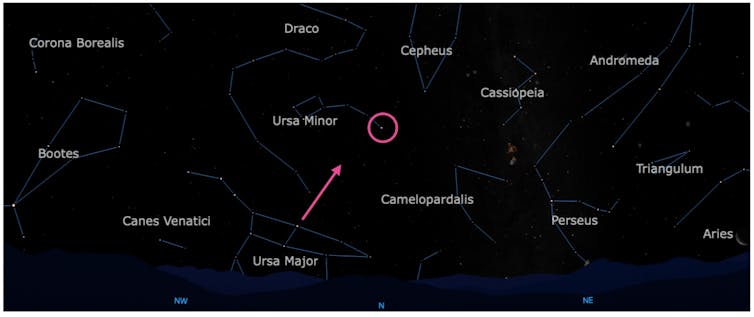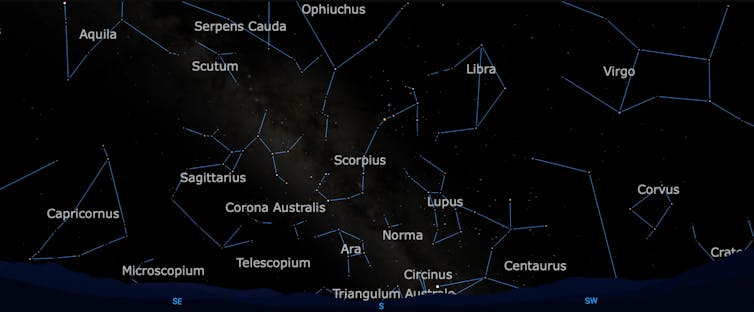If you have visited an island like one of the Hawaiian Islands, Tahiti or Easter Island, also known as Rapa Nui, you may have noticed how small these land masses appear against the vast Pacific Ocean. If you’re on Hawaii, the nearest island to you is more than 1,000 miles (1,600 kilometers) away, and the coast of the continental United States is more than 2,000 miles (3,200 kilometers) away. To say these islands are secluded is an understatement.
For me, watching the movie “Moana” in 2016 was eye-opening. I knew that Polynesian people traveled between a number of Pacific islands, but seeing Moana set sail on a canoe made me realize exactly how small those boats are compared with what must have seemed like an endless ocean. Yet our fictional hero went on this journey anyway, like the countless real-life Polynesian voyagers upon which she is based.
NASA
As an astronomer, I have been teaching college students and visitors to our planetarium how to find stars in our sky for more than 20 years. As part of teaching appreciation for the beauty of the sky and the stars, I want to help people understand that if you know the stars well, you can never get lost.
U.S. Navy veterans learned the stars in their navigation courses, and European cultures used the stars to navigate, but the techniques of Polynesian wayfinding shown in Moana brought these ideas to a very wide audience.
The movie Moana gave me a new hook – pun not intended – for my planetarium shows and lessons on how to locate objects in the night sky. With “Moana 2” out now, I am excited to see even more astronomy on the big screen and to figure out how I can build new lessons using the ideas in the movie.
The North Star
Have you ever found the North Star, Polaris, in your sky? I try to spot it every time I am out observing, and I teach visitors at my shows to use the “pointer stars” in the bowl of the Big Dipper to find it. These two stars in the Big Dipper point you directly to Polaris.

Starry Night Enthusiast/Christopher Palma
If you are facing Polaris, then you know you are facing north. Polaris is special because it is almost directly above Earth’s North Pole, and so everyone north of the equator can see it year-round in exactly the same spot in their sky.
It’s a key star for navigation because if you measure its height above your horizon, that tells you how far you are north of Earth’s equator. For the large number of people who live near 40 degrees north of the equator, you will see Polaris about 40 degrees above your horizon.
If you live in northern Canada, Polaris will appear higher in your sky, and if you live closer to the equator, Polaris will appear closer to the horizon. The other stars and constellations come and go with the seasons, though, so what you see opposite Polaris in the sky will change every month.
You can use all of the stars to navigate, but to do that you need to know where to find them on every night of the year and at every hour of the night. So, navigating with stars other than Polaris is more complicated to learn.
Maui’s fishhook
At the end of June, around 11 p.m., a bright red star might catch your eye if you look directly opposite from Polaris. This is the star Antares, and it is the brightest star in the constellation Scorpius, the Scorpion.
If you are a “Moana” fan like me and the others in my family, though, you may know this group of stars by a different name – Maui’s fishhook.
If you are in the Northern Hemisphere, Scorpius may not fully appear above your horizon, but if you are on a Polynesian island, you should see all of the constellation rising in the southeast, hitting its highest point in the sky when it is due south, and setting in the southwest.

Starry Night Enthusiast/Christopher Palma
Astronomers and navigators can measure latitude using the height of the stars, which Maui and Moana did in the movie using their hands as measuring tools.
The easiest way to do this is to figure out how high Polaris is above your horizon. If you can’t see it at all, you must be south of the equator, but if you see Polaris 5 degrees (the width of three fingers at arm’s length) or 10 degrees above your horizon (the width of your full fist held at arm’s length), then you are 5 degrees or 10 degrees north of the equator.
The other stars, like those in Maui’s fishhook, will appear to rise, set and hit their highest point at different locations in the sky depending on where you are on the Earth.
Polynesian navigators memorized where these stars would appear in the sky from the different islands they sailed between, and so by looking for those stars in the sky at night, they could determine which direction to sail and for how long to travel across the ocean.
Today, most people just pull out their phones and use the built-in GPS as a guide. Ever since “Moana” was in theaters, I see a completely different reaction to my planetarium talks about using the stars for navigation. By accurately showing how Polynesian navigators used the stars to sail across the ocean, Moana helps even those of us who have never sailed at night to understand the methods of celestial navigation.
The first “Moana” movie came out when my son was 3 years old, and he took an instant liking to the songs, the story and the scenery. There are many jokes about parents who dread having to watch a child’s favorite over and over again, but in my case, I fell in love with the movie too.
Since then, I have wanted to thank the storytellers who made this movie for being so careful to show the astronomy of navigation correctly. I also appreciated that they showed how Polynesian voyagers used the stars and other clues, such as ocean currents, to sail across the huge Pacific Ocean and land safely on a very small island thousands of miles from their home.




